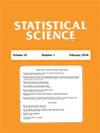在全球大流行期间担任公共卫生统计学家
IF 3.9
1区 数学
Q1 STATISTICS & PROBABILITY
引用次数: 5
摘要
从这个角度来看,我首先分享自2020年COVID-19大流行开始以来在印度建立SARS-CoV-2传播动态模型的经验教训。其次,我将讨论与COVID-19相关的一些有趣的开放问题,统计学家在未来几年可以做出很多贡献。最后,我强调需要建立综合和有弹性的公共卫生数据系统:良好的数据加上良好的模型是有效决策的核心。本文章由计算机程序翻译,如有差异,请以英文原文为准。
Being a Public Health Statistician During a Global Pandemic
In this perspective, I first share some key lessons learned from the experience of modeling the transmission dynamics of SARS-CoV-2 in India since the beginning of the COVID-19 pandemic in 2020. Second, I discuss some interesting open problems related to COVID-19 where statisticians have a lot to contribute to in the coming years. Finally, I emphasize the need for having integrated and resilient public health data systems: good data coupled with good models are at the heart of effective policymaking.
求助全文
通过发布文献求助,成功后即可免费获取论文全文。
去求助
来源期刊

Statistical Science
数学-统计学与概率论
CiteScore
6.50
自引率
1.80%
发文量
40
审稿时长
>12 weeks
期刊介绍:
The central purpose of Statistical Science is to convey the richness, breadth and unity of the field by presenting the full range of contemporary statistical thought at a moderate technical level, accessible to the wide community of practitioners, researchers and students of statistics and probability.
 求助内容:
求助内容: 应助结果提醒方式:
应助结果提醒方式:


